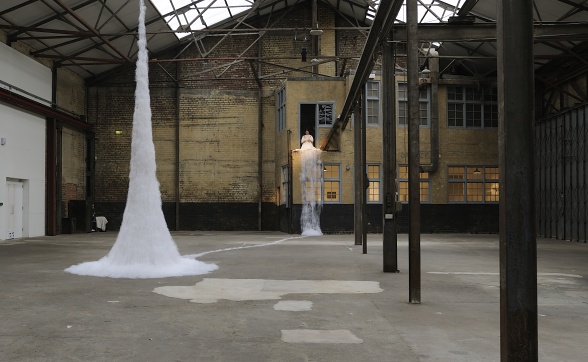Sachiko Abe

Sachiko Abe, Cut papers, 2010. Photograph by Thierry Bal

Sachiko Abe, Cut papers, 2010. Photograph by Thierry Bal
Sachiko Abe, Cut papers, 2010. Photograph by Thierry Bal
Sachiko Abe’s work encompasses performance, drawing, film and sculptural installations using cut papers accumulated over the last seven years. Her practice explores duration, repetition and constraints. This is a paradox, as she first started creating artworks after leaving the Self-Defense Forces in Japan because ‘the life of artists seemed so free’.
Her work since 1997 has explored the regimes of subjectivity that are imposed by society, most explicitly in her series of performance works, Elevator Girl Friend, in which she contravened the conventional behaviour of the demure elevator assistants employed by big department stores. Abe comments: ‘While the job sounds boring, it was a “dream job” for young girls because it was believed then that only the most beautiful and elegant person could be assigned to be an elevator girl.’
Her more recent works continue to explore disquieting routines that provoke anxiety and touch us in ways we cannot explain. Cut Papers is a series of works that created a surplus of meaning within an apparently simple aesthetic economy. In Cut Papers Abe invited the audience to experience an intimate space in which the constant snipping of scissor blades was the only measure of time passing.
For Touched Abe performed for the duration of the Biennial. ‘Be warned,’ Abe says, ‘my work is neither beautiful nor meditational’. Rather, it’s an aesthetic paradox that locates the artist at the centre of a field of reciprocal subjectivity: she is an object of the gaze that returns the subject to him or herself, by activating a feedback loop. It is this scenic space of perception and production that is the focus of the work.
Abe presented the performance in an environment of large-scale sculptural interventions in A Foundation’s Furnace Gallery, along with a new large-scale drawing work produced earlier (during her 2010 residency with A Foundation funded by the Pola Foundation). Intensive durational periods of drawing produce an intricate graphic weave, perhaps best approached through the dimension of ‘the fold’ as expressed by French philosopher Gilles Deleuze. Like Cut Papers, Abe’s drawings invited us to contemplate the intensity of ideas that accumulate and disseminate in the transformation of a white sheet of paper into a medium of communication.
Sachiko Abe at Liverpool Biennial 2010
Cut Papers, 2010
Paper, scissors, wire
Commissioned by A Foundation for Liverpool Biennial 2010
Exhibited at A Foundation Liverpool
Supported by
EU Japan Fest
The Great Britain Sasakawa Foundation
Japan Foundation
Links
Liverpool Biennial
55 New Bird Street
Liverpool L1 0BW
- T +44 (0)151 709 7444
- info@biennial.com
Liverpool Biennial is funded by
Founding Supporter
James Moores